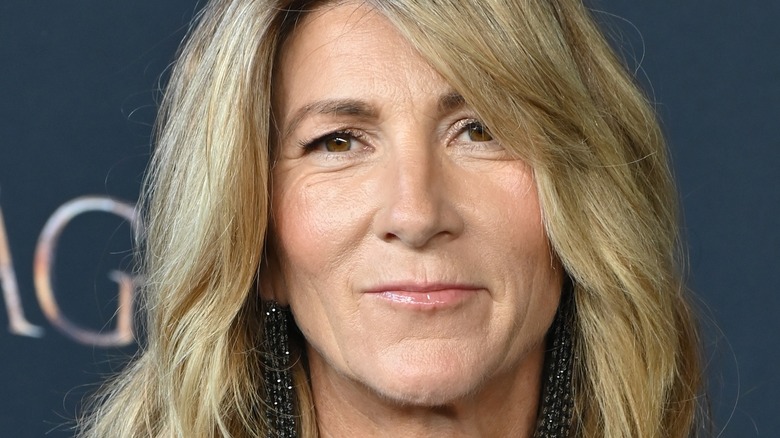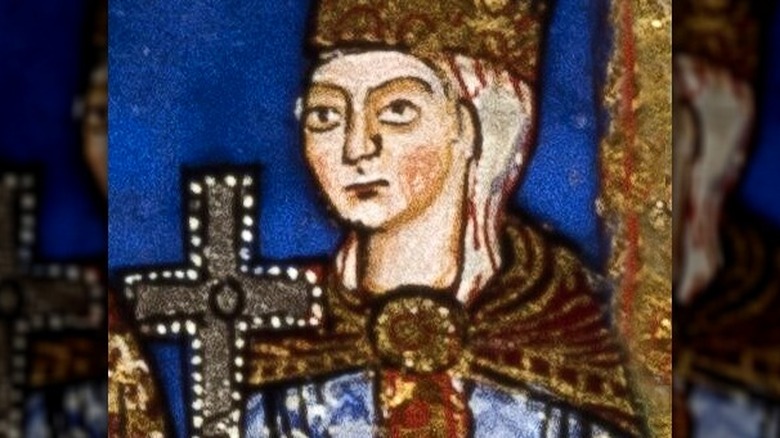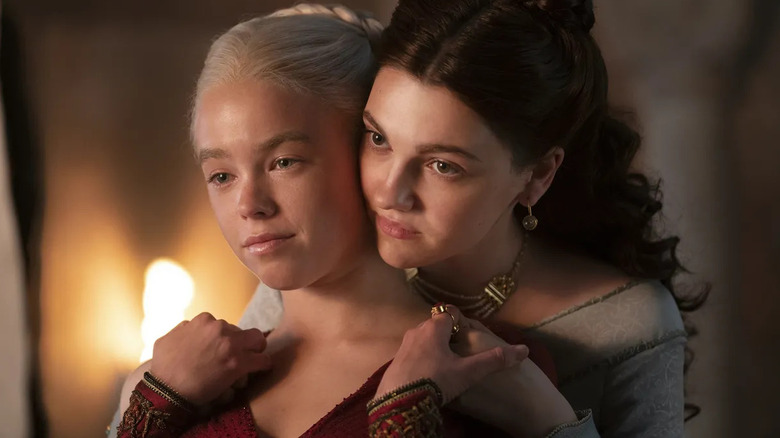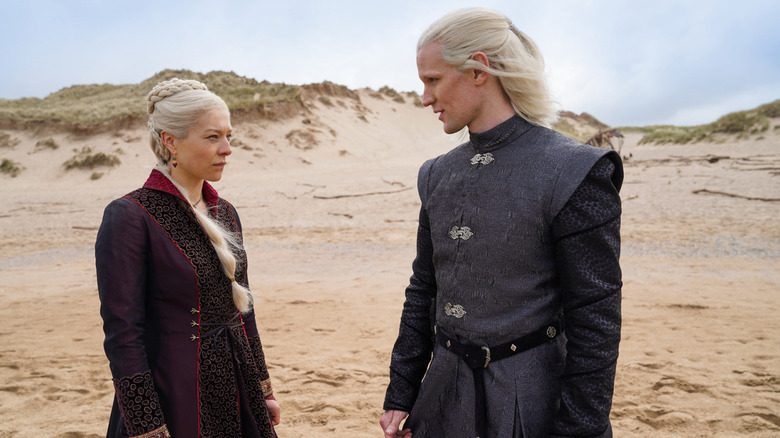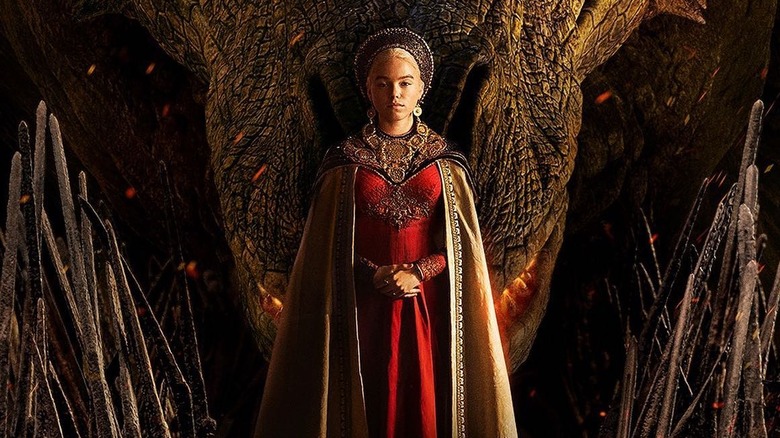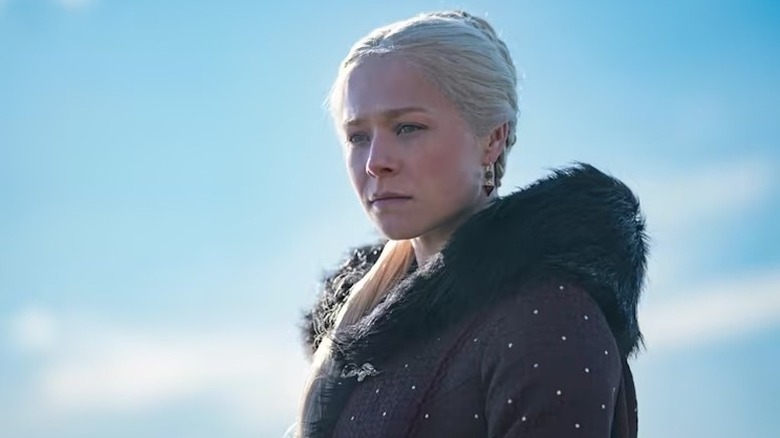House Of The Dragon's Queen Who Never Was Is Based On A Real Person
"Game of Thrones," the Emmy-winning HBO series, was based on author George R.R. Martin's "A Song of Ice and Fire." Per The Hollywood Reporter, more than 44 million viewers across 173 countries watched the mega fantasy's 8th and final season, making it HBO's most-watched series ever. Though it was based on a bestselling novel, much of "Game of Thrones" was, in fact, inspired by real-world events.
For instance, the penultimate episode of Season 3, in which Robb Stark, the King in the North, and his mother Lady Catelyn Stark, were massacred during the Red Wedding, was inspired by the 15th-century Black Dinner and the 17th-century Glencoe Massacre (via TIME). Westeros' 700-feet Wall, meanwhile, was built to protect the Seven Kingdoms from the white walkers and the wildlings; similarly, Emperor Hadrian built the 73-mile-long Roman Wall to guard the north of England (via BBC News).
HBO's latest fantasy action series "House of the Dragon," a prequel to "Game of Thrones," is based on Martin's "Fire and Blood." Historical events also inspire the highly anticipated series about the Targaryen civil war. Speaking at this year's Comic-Con, Martin explained, "'Game of Thrones,' as many people observed, is based loosely on the War of the Roses. ['House of the Dragon'] is based on an earlier period of history called The Anarchy," as reported by Entertainment Weekly.
The central character in "House of the Dragon" is Princess Rhaenyra Targaryen. Still, another woman in her family who came before her, Rhaenys Targaryen, was passed over for the crown in favor of a male relative — she was known as the Queen Who Never Was. But, what is the meaning behind that unique moniker, and was she inspired by a real-life person? As it turns out, both Rhaenys and Princess Rhaenyra might have been inspired by the same historical figure.
Who was Empress Matilda?
Empress Matilda was the daughter of Henry I, the king of England. In 1110, when Matilda was 8 years old, her father agreed to a marriage on her behalf to 24-year-old King Henry V of Germany in a politically motivated alliance (via the Historia).
After the king of England lost his son William to drowning in 1120, and Matilda lost her husband in 1125, Henry I named Matilda his heir to the English throne. Unfortunately, she could not become queen after her father died in 1135, as a civil war broke out — a war Matilda would end up fighting until her death in 1167.
Speaking at the "House of the Dragon" Comic-Con panel, author George R.R. Martin provided more background on Matilda's story. "He [Henry I] made all the lords of the kingdom swear their fealty to her. And then, some years later, he died, and most of the lords of the kingdom forgot about that oath," he said, per SlashFilm.
Martin continued, "They said oh, it doesn't apply, because here comes her cousin Stephen who crosses the Channel quickly and steals the treasury and gets himself crowned king, and you entered a period called The Anarchy, where Maud, or Matilda as she was known, and Stephen fought [for] a decade, two decades, whatever — it got horrible and bloody."
A fighter who challenged patriarchy
In "House of the Dragon," the Targaryens reject the idea of a woman — Princess Rhaenyra — as heir to the throne. The civil war that breaks out, known as the Dance of the Dragons, mirrors that of Matilda's fight with her cousin Stephen.
When Stephen seized the throne following King Henry I's death, despite an earlier oath of loyalty to Matilda, he was able to do so since most of the lords preferred a king, not a queen, to rule over the kingdom.
The Anarchy between Matilda and Stephen dragged on for years because Matilda wouldn't give up. According to Historia, she captured Stephen at the Battle of Lincoln in 1141. Despite the victory, however, she was forced to flee from Westminster on the eve of her coronation, as most barons refused to be ruled by a female monarch.
When asked why Westeros in "House of the Dragon" has issues with a woman becoming the king, George R.R. Martin said, per IGN, "That was the inspiration there. I don't think Westeros is any more anti-woman than real life. What we call actual history."
A queen in a king's world
Empress Matilda didn't have any children at the time of Henry I's death. To assert her claim to the throne, a then-25-year-old Matilda married 13-year-old Geoffrey of Anjou in 1128; they would go on to have three sons, per Historic UK.
As told by Historia, though Geoffrey, son of a count, fought for Matilda's recognition as queen, Stephen did not relinquish the throne. When Henry II, her eldest son, grew up, Matilda negotiated with the Church and signed the Treaty of Wallingford in 1153. Stephen was allowed to be king of England until his death. Before he passed away in 1154, he was forced to announce Henry II as his successor.
A contemporary chronicler observed, per the BBC's History Extra: "Forgetting the weakness of her sex and a woman's softness, she bore herself with the valour of a man. Everywhere, by prayer or price, she won over invincible allies. She urged the King's lieges to demand their lord back to her."
Is Princess Rhaenyra Empress Matilda?
Matilda's epitaph reads: If ever a woman deserved to be carried by the hands of angels to Heaven, it was this holy queen (via History Extra). Empress Matilda, much like Princess Rhaenyra in "House of the Dragon," was given the right to rule an inherently misogynistic society. Similar to how Matilda's cousin Stephen claimed the throne for himself, despite Henry I naming Matilda his rightful heir, in "House of the Dragon," Rhaenyra's half-brother Aegon II proclaims himself as king. Both Matilda and Rhaenyra were chosen by their fathers to rule as queens, and they would fight for that rightful title.
"Matilda could have given up. It would have been quite easy to give up, to go, 'Oh, hang on, I'm stuck 200 miles away' — she was in Anjou, in France at the time — and somebody else has been crowned and he's a man and nobody seems to be arguing on my behalf. Maybe I should just stay here. But quite clearly, she wasn't that kind of woman," historian Catherine Hanley told Jezebel. "She wasn't just to sit by and let somebody else steal her rights. And so instead of taking this lying down, she decided to start a war about it. Good for her! She didn't have any dragons, sorry."
Who is Princess Rhaenyra?
Emma D'Arcy plays Princess Rhaenyra Targaryen in "House of the Dragon." The 30-year-old actor identifies as nonbinary and uses gender-neutral pronouns. "Rhaenyra is deeply interested in gender dynamics; she has really keen awareness for the different space that men and women are afforded. She feels at odds with the way that she's read," Emma told iNews. "I think she's seeking a way of living that feels authentic. I find that very moving."
Princess Rhaenyra is "of pure Valyrian blood and a dragonrider," per HBO. She rides a large dragon named Syrax, and though her claim to the Iron Throne is questioned simply because she is female, Rhaenyra proves herself fierce, smart, and compassionate (via Forbes).
As Esquire notes, while Matilda was able to restore her lineage to the English throne (via the Treaty of Wallingford), Rhaenyra's fate in "House of the Dragon" is far more tragic. The inspiration for the Queen Who Never Was may have been Empress Matilda, but George R.R. Martin apparently chose, in the end, to take inspiration only so far.
